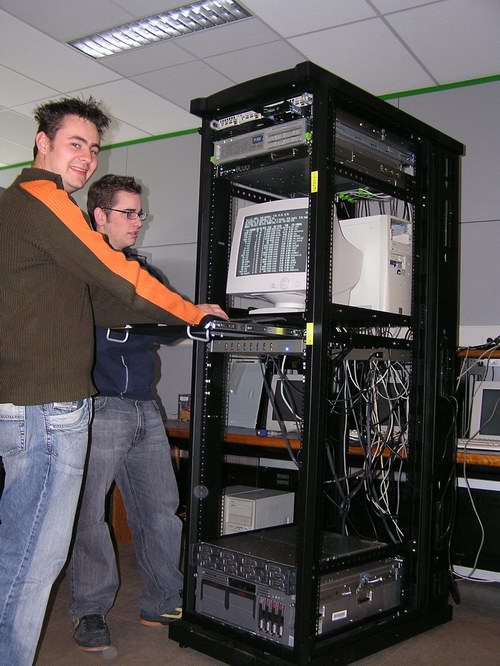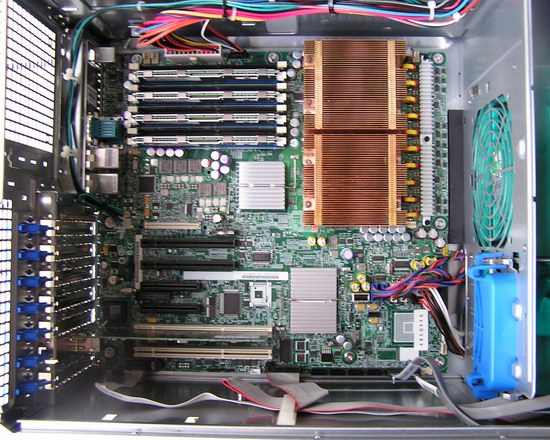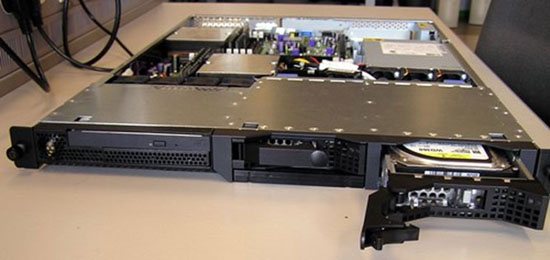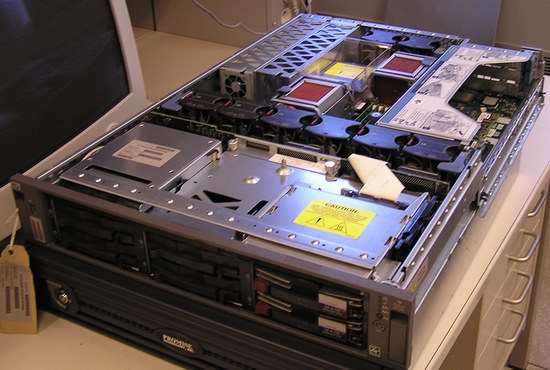Intel Woodcrest, AMD's Opteron and Sun's UltraSparc T1: Server CPU Shoot-out
by Johan De Gelas on June 7, 2006 12:00 PM EST- Posted in
- IT Computing
Words of Thanks
A lot of people gave us assistance with this project, and we like to thank them of course.
Waseem Ahmad, Intel US
Matty Bakkeren, Intel Netherlands
Trevor E. Lawless, Intel US
(www.intel.com)
Chhandomay Mandal, Sun US
Luojia Chen, Sun US
Peter A. Wilson, Sun US
(www.sun.com)
Peter Zaitsev, Elite MySQL Guru
(www.mysql.com)
Damon Muzny, AMD US
(www.amd.com)
Steve Olson, Sybase US
(www.sybase.com)
Erwin Vanluchene, HP Belgium
(www.hp.be)
Ilona van Poppel, MSI Netherlands
Ruudt Swanen, MSI Netherlands
(www.msi-computer.nl)
Alexander Goodrich, Assembler Guru
Bert Devriese, Developer of MySQL & PHP benchmark
Dieter Saeys, Gentoo/Linux support
Brecht Kets, Development of Improved Bench program
Tijl Deneut, Solaris, PostGreSQL and MySQL support
I also like to thank Lode De Geyter, manager of the University College of West-Flanders. Further information about our server research is available on our website.
Benchmark Configuration
We used Solaris 10 for the Sun T2000, as the only supported OS for the T2000 right now is Solaris 10 3/05 HW2 (and upwards). The T1 is fully binary compatibility with the existing SPARC binaries but needs this version of Solaris.
Below is a picture of our Server lab at the University College of West-Flanders. You can see Bert and Dieter standing next to our brand new rack of the server research lab.

From top to bottom, we have the Supermicro SuperServer 6014P-32, the MSI K2-102A2M, the Sun T2000, our own PIII based Linux gateway and firewall, and at the bottom, the Promise JBOD300s and the HP DL585. Yes, we still have a lot of benchmarking to do. The other Intel based machines are in towers, so you won't find them in our rack.
All benchmarking is monitored: CPU load, network and disk I/O are watched using CPU graph, top, vmstat and prstat. This way we can determine whether or not the CPU or another component is the bottleneck.
Our web server tests are performed on Apache2 2.0.55, including the mod_deflate module for gzip compression, PHP4.4.1 and Mysql 5.0.21.
Hardware Configurations
Here is the list of the different server configurations:
Sun T2000:
Sun UltraSparc T1 1 GHz, 8 cores, 32 threads
Sun Solaris 10
32 GB (16x2048 MB) Crucial DDR-2 533
NIC: 1 Gb Intel RC82540EM - Intel E1000 driver.
You can find much more information about the T1 CPU in our previous article.
Intel Server 1:
Dual Intel Xeon "Woodcrest" 3 GHz Shared 4 MB L2 cache, 1333 MHz FSB (4 cores total)

Blackford Chipset
64 bit Gentoo Kernel 2.6.15-gentoo-r7
Intel Server Board S5000
4 GB (4x1024 MB) Micron FB-DIMM Registered DDR2-533 CAS 4, ECC enabled
NIC: Dual Intel PRO/1000 Server NIC
2x Western Digital Raptor 36 GB SATA
Intel Server 2:
Dual Intel Xeon "Irwindale" 3.6 GHz 2 MB L2 cache, 800 MHz FSB - Lindenhurst
64 bit Gentoo Kernel 2.6.15-gentoo-r7
Intel Server Board SE7520AF2
8 GB (8x1024 MB) Micron Registered DDR2-400 CAS 3, ECC enabled
NIC: Dual Intel PRO/1000 Server NIC (Intel 82546GB controller)
2x Western Digital Raptor 36 GB SATA
Opteron Server 1: Dual Opteron 275 2.2 GHz 2x1MB L2 cache (4 cores total)
64 bit Gentoo Kernel 2.6.15-gentoo-r7
Solaris x86 10
MSI K8N Master2-FAR
4 GB: 4x1GB MB Crucial DDR-400 (3-3-3-6)
NIC: Broadcom BCM5721 (PCI-E)
2x Western Digital Raptor 36 GB SATA
Opteron Server 2: MSI K2-102A2M

ServerWorksHT2000 Chipset
64 bit Gentoo Kernel 2.6.15-gentoo-r7
4 GB: 4x1GB MB Crucial DDR-400 (3-3-3-6)
NIC: Broadcom BCM5721 (PCI-E)
2x Western Digital Raptor 36 GB SATA
Opteron Server 3: HP DL385

Solaris x86 10
AMD 81xx chipset
64 bit Gentoo Kernel 2.6.15-gentoo-r7
4 GB: 4x1GB MB Crucial DDR-400 (3-3-3-6)
NIC: Broadcom BCM5721 (PCI-E)
2x Seagate Cheetah 36 GB - 15000 rpm - SCSI 320 MB/s
Client Configuration: Dual Opteron 850
MSI K8T Master1-FAR
4x512 MB Infineon Registered DDR-333, ECC
NIC: Broadcom 5705
Common Software
64 bit Gentoo Kernel 2.6.15-gentoo-r7
Apache2 2.0.55 + mod_deflate module for gzip compression.
PHP4.4.1
Mysql5.0.21
A lot of people gave us assistance with this project, and we like to thank them of course.
Waseem Ahmad, Intel US
Matty Bakkeren, Intel Netherlands
Trevor E. Lawless, Intel US
(www.intel.com)
Chhandomay Mandal, Sun US
Luojia Chen, Sun US
Peter A. Wilson, Sun US
(www.sun.com)
Peter Zaitsev, Elite MySQL Guru
(www.mysql.com)
Damon Muzny, AMD US
(www.amd.com)
Steve Olson, Sybase US
(www.sybase.com)
Erwin Vanluchene, HP Belgium
(www.hp.be)
Ilona van Poppel, MSI Netherlands
Ruudt Swanen, MSI Netherlands
(www.msi-computer.nl)
Alexander Goodrich, Assembler Guru
Bert Devriese, Developer of MySQL & PHP benchmark
Dieter Saeys, Gentoo/Linux support
Brecht Kets, Development of Improved Bench program
Tijl Deneut, Solaris, PostGreSQL and MySQL support
I also like to thank Lode De Geyter, manager of the University College of West-Flanders. Further information about our server research is available on our website.
Benchmark Configuration
We used Solaris 10 for the Sun T2000, as the only supported OS for the T2000 right now is Solaris 10 3/05 HW2 (and upwards). The T1 is fully binary compatibility with the existing SPARC binaries but needs this version of Solaris.
Below is a picture of our Server lab at the University College of West-Flanders. You can see Bert and Dieter standing next to our brand new rack of the server research lab.

From top to bottom, we have the Supermicro SuperServer 6014P-32, the MSI K2-102A2M, the Sun T2000, our own PIII based Linux gateway and firewall, and at the bottom, the Promise JBOD300s and the HP DL585. Yes, we still have a lot of benchmarking to do. The other Intel based machines are in towers, so you won't find them in our rack.
All benchmarking is monitored: CPU load, network and disk I/O are watched using CPU graph, top, vmstat and prstat. This way we can determine whether or not the CPU or another component is the bottleneck.
Our web server tests are performed on Apache2 2.0.55, including the mod_deflate module for gzip compression, PHP4.4.1 and Mysql 5.0.21.
Hardware Configurations
Here is the list of the different server configurations:
Sun T2000:
Sun UltraSparc T1 1 GHz, 8 cores, 32 threads
Sun Solaris 10
32 GB (16x2048 MB) Crucial DDR-2 533
NIC: 1 Gb Intel RC82540EM - Intel E1000 driver.
You can find much more information about the T1 CPU in our previous article.
Intel Server 1:
Dual Intel Xeon "Woodcrest" 3 GHz Shared 4 MB L2 cache, 1333 MHz FSB (4 cores total)

Blackford Chipset
64 bit Gentoo Kernel 2.6.15-gentoo-r7
Intel Server Board S5000
4 GB (4x1024 MB) Micron FB-DIMM Registered DDR2-533 CAS 4, ECC enabled
NIC: Dual Intel PRO/1000 Server NIC
2x Western Digital Raptor 36 GB SATA
Intel Server 2:
Dual Intel Xeon "Irwindale" 3.6 GHz 2 MB L2 cache, 800 MHz FSB - Lindenhurst
64 bit Gentoo Kernel 2.6.15-gentoo-r7
Intel Server Board SE7520AF2
8 GB (8x1024 MB) Micron Registered DDR2-400 CAS 3, ECC enabled
NIC: Dual Intel PRO/1000 Server NIC (Intel 82546GB controller)
2x Western Digital Raptor 36 GB SATA
Opteron Server 1: Dual Opteron 275 2.2 GHz 2x1MB L2 cache (4 cores total)
64 bit Gentoo Kernel 2.6.15-gentoo-r7
Solaris x86 10
MSI K8N Master2-FAR
4 GB: 4x1GB MB Crucial DDR-400 (3-3-3-6)
NIC: Broadcom BCM5721 (PCI-E)
2x Western Digital Raptor 36 GB SATA
Opteron Server 2: MSI K2-102A2M

ServerWorksHT2000 Chipset
64 bit Gentoo Kernel 2.6.15-gentoo-r7
4 GB: 4x1GB MB Crucial DDR-400 (3-3-3-6)
NIC: Broadcom BCM5721 (PCI-E)
2x Western Digital Raptor 36 GB SATA
Opteron Server 3: HP DL385

Solaris x86 10
AMD 81xx chipset
64 bit Gentoo Kernel 2.6.15-gentoo-r7
4 GB: 4x1GB MB Crucial DDR-400 (3-3-3-6)
NIC: Broadcom BCM5721 (PCI-E)
2x Seagate Cheetah 36 GB - 15000 rpm - SCSI 320 MB/s
Client Configuration: Dual Opteron 850
MSI K8T Master1-FAR
4x512 MB Infineon Registered DDR-333, ECC
NIC: Broadcom 5705
Common Software
64 bit Gentoo Kernel 2.6.15-gentoo-r7
Apache2 2.0.55 + mod_deflate module for gzip compression.
PHP4.4.1
Mysql5.0.21










91 Comments
View All Comments
JohanAnandtech - Thursday, June 8, 2006 - link
I should have mentioned this: most of the tests have also been done on SUSE linux SLES9. The reason why we use Gentoo is that we are able to use the latest kernel and to tune the kernel specifically for the AMD or Intel architecture.With SUSE Enterprise you need to wait for SUSE to use a new kernel. Your suggestion is noted, and from now on I will include the SUSE SLES numbers too.
But to call our numbers useless, well that is a heavy exageration. There was about 1-2% difference between running on Gentoo than on SUSE. It is only natural: they both use more or less the same kernel, only the tools are different.
ashyanbhog - Thursday, June 8, 2006 - link
"Two months of testing and tweaking"so thats the time you took to make sure you could say
"In one word: Woodcrest rocks!"
and suprisingly your emotions were quite tepid when AMD processors where showing similar performance advantages over Intel processors earlier!
http://www.anandtech.com/IT/showdoc.aspx?i=2447&am...">http://www.anandtech.com/IT/showdoc.aspx?i=2447&am...
ashyanbhog - Thursday, June 8, 2006 - link
What 1-2% difference b/w SLES and Gentoo are you talking about? Anand's own earlier benchmarks show SLES performance as 9-17% better than than Gentoo!http://www.anandtech.com/IT/showdoc.aspx?i=2447&am...">http://www.anandtech.com/IT/showdoc.aspx?i=2447&am...
If you have specifically used Gentoo for the optimization options that it provides, why didn't you list the specific compile time optimizations for Intel and AMD that were finally used to run the benchmarks? The purpose of a independent benchmark is to ensure a setup that is neutral and verifiable by any third party using similar hardware and software. Does your review report provide the info necessary for the same?
Your earlier benchmarks using Linux + DB2 show dual dual core opterons gaining 50% - 80% improvement over dual single core opteron when more than 5 threads come into picture, and a mere 1% to 2% gain in case of one or two threads. Okay, I know DB2 was not part of this benchmarks this around, but shoudn't these figures have setoff enough alarm bells to force inclusion of something other than MySQL for database benchmarks?
Even MySQL on gentoo shows a modest 10% to 17% gain with concurrency numbers from 5 and higher in Sinle Core + Dual CPU vs Dual Core + Dual CPU. Strange that Linux and MySQL misbehave on Opteron this time and show a 10% performance degradation! You deserve a award for this! How can somebody contradict their own earlier benchmarks?
http://www.anandtech.com/IT/showdoc.aspx?i=2447&am...">http://www.anandtech.com/IT/showdoc.aspx?i=2447&am...
The MSI motherboard you used for the benchmarks has only a single channel to the memory bank for both the processors, a comprise made to cut its price and compete in the lowest market segment for 2P Opteron boards. A major design feature of the Opteron is its ability to use seperate memory channels for each procesor giving it NUMA capabilities, and dedicated memory lanes also cut lantencies when accessing the memory. Did you specifically choose this motherboard to negate opterons advantage? The Intel board used for "Irwindale" retails for around $500, the price for one used for woodcrest is not known, the MSI board is available for $250, so even the price range is different! "relatively cheap workstation board" as you noted in your earlier benchmarks. Were Tyan K8WE, ASUS K8N-DL, Supermicro H8DCi or the Iwill DK8EW that are more popular, so hard to come by? Also you dont specify which of the three opteron systems was used for which benchmark, or was it a average of three. The extreme attention to details usually found at Anand is suprisingly lacking for this review
http://www.ocforums.com/showthread.php?t=459111">http://www.ocforums.com/showthread.php?t=459111
http://forums.amd.com/lofiversion/index.php/t56855...">http://forums.amd.com/lofiversion/index.php/t56855...
http://geek.pricegrabber.com/search_getprod.php/ma...">http://geek.pricegrabber.com/search_getprod.php/ma...
http://geek.pricegrabber.com/search_getprod.php/ma...">http://geek.pricegrabber.com/search_get...php/mast...
Arent temprature readings also important, specially for a new xeon chip, as earlier ones had forced admins to double their AC capacities and discard covers of rack cabinets for better cooling.
Its good to know Intel is back on track, but this review seems to have only one purpose - Show woodcrest in favorable light against opterons.
rayl - Wednesday, June 7, 2006 - link
It doesn't take a server to compute that "Woodcrest rocks" = 2 words. :pmerlinm - Wednesday, June 7, 2006 - link
where are the postgresql quad core benchmarks? My experience is that 2-4 cores on postgresql gives you 1.7x the power on non i/o constrained databases. This would have been a huge upset to have PostgreSQL blow out mysql in a quad core configuration.also a postgresql.conf containing non-default values would have been nice.
blackbrrd - Wednesday, June 7, 2006 - link
Where does it say they are using the default postgresql.conf? Actually I can't find any information on what kind of tweaking that has been done here at all?Is there any special reason for only running postgresql on a single cpu instead of a dual dual core setup like you did for the rest of the tests? There are no commends about it on http://www.anandtech.com/IT/showdoc.aspx?i=2772&am...">page 9 atleast...
merlinm - Wednesday, June 7, 2006 - link
right...what I meant was, could you please supply .conf entries which where edited and changed from the stock configuration. Actually, for this type of benchmark (90% read), there's not a whole lot to change in postgresql.conf...generally the more writes there are the more you have to tweak.the major tweak in postgresql is to use prepared statements over the parameterized interface...
merlinm - Wednesday, June 7, 2006 - link
oh, and postgresql 8.1 is about 20+% faster than 8.0 in most read operations involving very small (one statement) transactions.squash - Wednesday, June 7, 2006 - link
Hello,With the recent "official" support in Ubuntu for that Niagra server, would it be possible to also include performance numbers for that server running Linux?
I have seen other benchmarks showing Linux to have improved performance on the same hardware compared to Solaris. Filesystem performance is typically much higher in ext2 vs ufs+logging, and if you scan Sun's issue tracking database, there are many entries for libc and kernel operations which are much slower than Linux.
Maybe as a seperate article....
Squash
OddTSi - Wednesday, June 7, 2006 - link
The Verify/s graph (the last one on the page) doesn't have a line for the Dual Opteron yet the author still claims "Again, the Opteron takes the lead." Does the Dual Opteron take the lead and there was just an error in showing up on the graph?Also in the signs/s chart the Dual Woodcrest tops out at just over 6,000 and the Dual Opteron tops out at just over 5,000, which is a 20% lead, yet the author writes "The Opteron at 2.4 GHz has no trouble keeping up with the 3 GHz Woodcrest." I'm not trying to be a nitpicky fanboy here but being beaten by 20% isn't "keeping up," at least not in my defition of the expression.
Finally, I have a question. Why are there no Windows-based tests? I know that LAMP is very popular in the webserving part of the server world but in most other server/enterprise areas it's mostly Windows, SQL Server, Visual Studio, .NET, etc. I'd like to see some benchmarks that use software that those of us in the non-webserving community are most likely to use. I know there's no chance of running the UltraSPARC in a Windows configuration but quite frankly who cares. I would like to see which of the x86 offerings (which is FAR more likely to be used) is better.